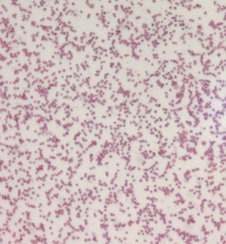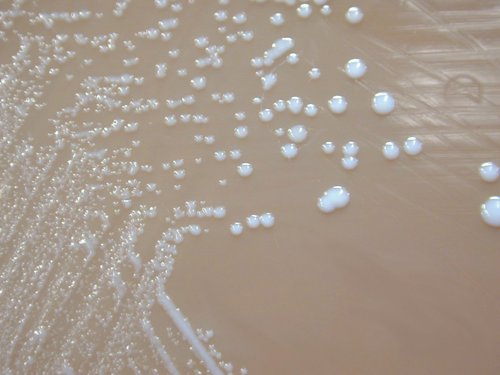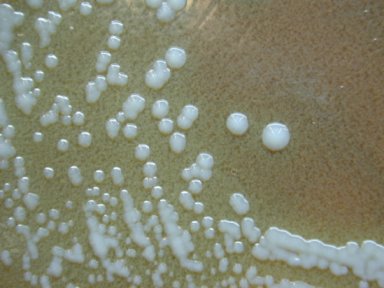Specimen Source
May be isolated from:
- Blood
- Sputum
- Bronchial washings
- Lymph nodes
- Wounds
- Skin lesion exudates
These specimens present an exposure risk to the laboratorian. F. tularensis is highly infectious! Once this organism is suspected on the basis of clinical and/or laboratory information, do not perform additional testing. Send the isolate to the South Dakota State Laboratory for identification.
Gram Stain

- Tiny, pleomorphic, poorly staining gram-negative coccobacillus (0.2 to 0.5 by 0.7 to 1.0 microns). In clinical specimens, these forms can be found intracellularly.
- Seen mostly as single cells.
- Bipolar staining is not a distinctive feature.
Colony Characteristics
F. tularensis is highly infectious! Once this organism is suspected on the basis of clinical and/or laboratory information, do not perform additional testing. Send the isolate to the South Dakota State Laboratory for identification.
F. tularensis is a fastidious organism and requires cysteine for best growth.
Commercial sheep blood agar may contain cysteine. Cystine enriched chocolate agar, Martin Lewis, Thayer-Martin, cysteine heart agar with blood (CHAB), and buffered charcoal yeast extract agar (BCYE) will support growth of the organism.
Sheep blood agar (SBA) – Poor growth at 24 hours. At 48 to 72 hours, colonies are 1 to 2 mm, grey-white, and nonhemolytic.


MacConkey agar – no growth.
Thioglycollate broth – slow, with denser band near top, diffusing with age.
Buffered charcoal yeast extract agar (BCYE) –
F. tularensis
will grow on BCYE. This media is used for isolation of . 1-3mm grey-white colonies at 48 to 72 hours.
Key Characteristics
F*. tularensis* is highly infectious! Once this organism is suspected on the basis of clinical and/or laboratory information, do not perform additional testing. Send the isolate to the South Dakota State Laboratory for identification.
- Gram-negative, tiny pleomorphic, poorly staining, coccobacillus.
- Sheep blood agar – grows poorly with very tiny colonies.
- Chocolate agar (cystine enriched) – grows slowly.
- Oxidase negative.
- Nonmotile.
- Urease negative.
- Beta-lactamase positive.
- X and V factors are not required.
Pitfalls
- Not in the database of most commercial systems.
- Caution: This organism looks like Haemophilus, but do not smell it. F. tularensis has been reported to cross intact skin. Leave lids on plates.
Look-a-likes
- H. influenzae
- Acinetobacter
- Actinobacillus
- H. aphrophilus
- Pasturella
- Bordetella
- Group IV
- Capnocytophaga
- Kingella
- Legionella
Safety
- F. tularensis is highly infectious! Once this organism is suspected on the basis of clinical and/or laboratory information, do not perform additional testing. Send the isolate to the South Dakota State Laboratory for identification.
- Use biosafety level 2 practices for specimen processing.
- Use biosafety level 3 practices for all activities involving manipulations of cultures
